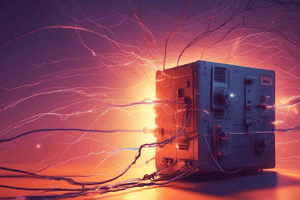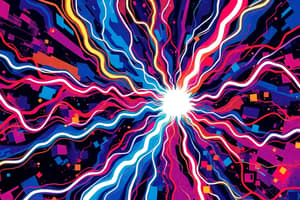Podcast
Questions and Answers
What is the primary function of an electric fuse?
What is the primary function of an electric fuse?
- To protect electrical appliances and prevent fires. (correct)
- To decrease the voltage in a circuit.
- To convert electrical energy into mechanical energy.
- To increase the flow of electricity in a circuit.
What is the principle on which an electric fuse operates?
What is the principle on which an electric fuse operates?
- The heating effect of electric current. (correct)
- The electrostatic effect of electric current.
- The magnetic effect of electric current.
- The chemical effect of electric current.
Boojho made an electromagnet with 50 turns of wire, while Paheli made one with 100 turns. Which electromagnet is stronger?
Boojho made an electromagnet with 50 turns of wire, while Paheli made one with 100 turns. Which electromagnet is stronger?
- Boojho's electromagnet is stronger.
- Paheli's electromagnet is stronger. (correct)
- Both electromagnets are equally strong.
- The strength of the electromagnet is determined by the type of wire used.
Why are multiple cells connected together called a battery?
Why are multiple cells connected together called a battery?
Which of the following is a precaution to be taken while using electricity in homes?
Which of the following is a precaution to be taken while using electricity in homes?
In an open circuit, the switch is in the ______ position, and the bulb ______.
In an open circuit, the switch is in the ______ position, and the bulb ______.
Which of the following is a characteristic of a closed circuit?
Which of the following is a characteristic of a closed circuit?
What is the primary factor that determines whether a magnetic field is created around a conductor?
What is the primary factor that determines whether a magnetic field is created around a conductor?
Which of the following is NOT a precaution related to using electricity in homes?
Which of the following is NOT a precaution related to using electricity in homes?
Which of the following is a potential consequence of experimenting with the electrical supply from the mains?
Which of the following is a potential consequence of experimenting with the electrical supply from the mains?
Which of the following characteristic is not suitable for a fuse wire?
Which of the following characteristic is not suitable for a fuse wire?
The magnetic effect of electric current was discovered by?
The magnetic effect of electric current was discovered by?
Continuous flow of electric current through a circuit requires?
Continuous flow of electric current through a circuit requires?
Which of the following does not work on the heating effect of electric current?
Which of the following does not work on the heating effect of electric current?
The strength of an electromagnet can be increased by?
The strength of an electromagnet can be increased by?
What causes the hammer in an electric bell to continue striking the gong repeatedly?
What causes the hammer in an electric bell to continue striking the gong repeatedly?
How does increasing the current affect the strength of an electromagnet?
How does increasing the current affect the strength of an electromagnet?
What happens when a fuse blows in an electrical circuit?
What happens when a fuse blows in an electrical circuit?
Which statement is true regarding the deflection of a magnetic compass near a current-carrying wire?
Which statement is true regarding the deflection of a magnetic compass near a current-carrying wire?
What is the primary difference between cells in series and cells in parallel when connected in a circuit?
What is the primary difference between cells in series and cells in parallel when connected in a circuit?
Flashcards
Fuse Wire Characteristics
Fuse Wire Characteristics
A fuse wire should be thin, short, and have a low melting point.
Oersted's Discovery
Oersted's Discovery
Hans Christian Oersted discovered the magnetic effect of electric current.
Continuous Current Requirement
Continuous Current Requirement
A continuous flow of electric current requires a source, conducting material, and a closed circuit.
Electromagnet Strength
Electromagnet Strength
Signup and view all the flashcards
Safety in Electric Circuits
Safety in Electric Circuits
Signup and view all the flashcards
Electric Bell Function
Electric Bell Function
Signup and view all the flashcards
Continuing Strikes in Bell
Continuing Strikes in Bell
Signup and view all the flashcards
Circuit Diagram Representation
Circuit Diagram Representation
Signup and view all the flashcards
Cells in Series vs. Parallel
Cells in Series vs. Parallel
Signup and view all the flashcards
Magnetic effect of electric current
Magnetic effect of electric current
Signup and view all the flashcards
Electric fuse
Electric fuse
Signup and view all the flashcards
Heating effect of electric current
Heating effect of electric current
Signup and view all the flashcards
Difference between open circuit and closed circuit
Difference between open circuit and closed circuit
Signup and view all the flashcards
Open circuit
Open circuit
Signup and view all the flashcards
Closed circuit
Closed circuit
Signup and view all the flashcards
Batteries vs Cells
Batteries vs Cells
Signup and view all the flashcards
Safety precautions with electricity
Safety precautions with electricity
Signup and view all the flashcards
Electromagnet comparison
Electromagnet comparison
Signup and view all the flashcards
Study Notes
Objective Type Questions
-
Fuse Wire Characteristics: A fuse wire should be thin and short, with a low melting point, and a higher resistance than the rest of the wiring.
-
Magnetic Effect of Electric Current: Oersted discovered the magnetic effect of electric current.
-
Continuous Current Flow: A continuous electric current flow requires a source of current, a conducting material, and a closed circuit.
-
Heating Effect of Electric Current: An electric bulb, miniature circuit breaker, and electric fuse all work on the heating effect of electric current; an immersion rod doesn't.
-
Electromagnet Strength: Increasing the number of coils will increase the strength of an electromagnet; decreasing the current strength will decrease the strength.
-
Electric Circuit Components: The diagram represents a battery/cell in a circuit for electric current (from context).
Very Short Answer Type Questions (2 Marks)
-
Series vs. Parallel Cells: Series cells connect the positive terminal of one cell to the negative of the next, while parallel cells connect similar terminals together.
-
Magnetic Effect of Current: The continuous flow of current through a conductor creates a magnetic field.
-
Electric Fuse: A safety device that protects electrical appliances by melting when current exceeds a safe limit; it works due to the heating effect.
-
Electromagnet Strength: A larger number of turns of wire on the electromagnet results in a stronger electromagnet, attracting more pins.
Short Answer Type Questions (3 Marks)
-
Battery vs. Cells: A battery is a collection of cells in a configuration where connections are internal rather than external.
-
Safety Precautions in Electrical Use: Never touch a hot/lighted bulb connected to mains/generator/inverter, and use only batteries/cells in experiments.
-
Open vs. Closed Circuits: An open circuit has a break and does not allow current to flow; a closed circuit is complete and lets current pass.
-
Low Melting Point Fuse Wire: Low melting point is crucial to the fuse wire's ability to break the circuit/stop electrical flow when current is too high. This prevents further damage to the circuit.
-
Excessive House Current: Causes of excessive house current include direct wire contact and connecting too many devices to a single socket (overloading).
Long Answer Type Questions (5 Marks)
-
Electromagnet Uses: Loudspeakers, electrical bells, cranes, measuring instruments (telephones, refrigerators, generators), and separating magnetics materials from junk.
-
Electric Circuit: An interrupted path where electrical current flows, typically containing electrical components (sources, wires, etc.).
-
Electric Bell Operation: An electromagnet attracting the soft metal armature causes it to strike a gong; the release and repetition of this process due to the spring mechanism creates the ringing sound.
Source-Based/Case Study Questions
-
Incandescent vs. Efficient Bulbs: Incandescent bulbs waste energy as heat; efficient bulbs, like LEDs, use less energy to produce the same light output.
-
Heating Effect of Current: Electric current passing through a wire produces heat.
-
Disposal of Damaged Fluorescent Bulbs: Damaged fluorescent and CFL bulbs should be disposed of safely as they contain mercury vapour, which is toxic.
-
Factors Affecting Wire Heating: The heat produced in a wire depends on the type of material, its length, thickness, and the current flowing through it.
Studying That Suits You
Use AI to generate personalized quizzes and flashcards to suit your learning preferences.




